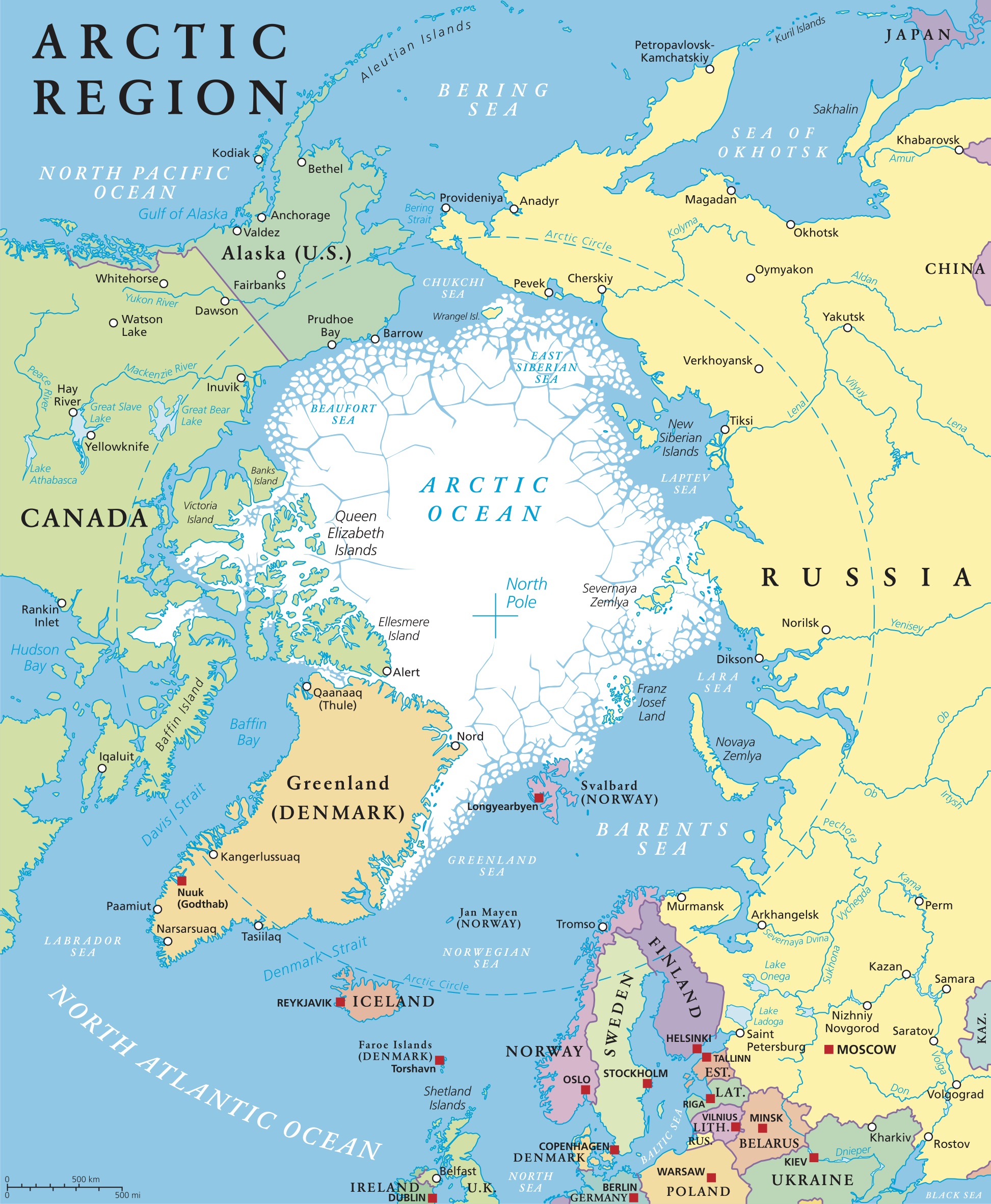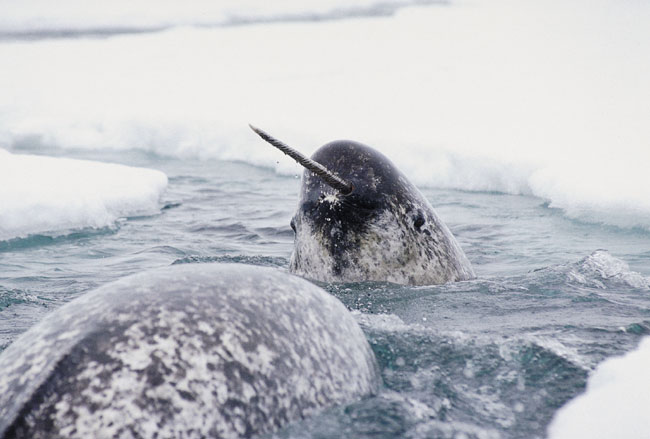The Arctic Circle: Polar portal to the Arctic
Pass beyond this latitude and you will have trekked nearly as far north as you can go on Earth.

The Arctic Circle is an imaginary line of latitude that circles Earth's northernmost end. Not to be confused with it's colder, Southern Hemisphere counterpart known as the Antarctic Circle, the Arctic Circle is located approximately 66.5 degrees north of the equator (the exact coordinates vary slightly depending on Earth's axial tilt), and marks the southern border of the Arctic. Because of this, the Arctic Circle is often used as a reference point to express proximity to the Arctic region.
Geography
The Arctic Circle covers an area about 5.5 million square miles (14.5 million square kilometers), according to the Woods Hole Oceanographic Institute. That's slightly less than 3% of Earth's surface area. At the Arctic's center lies the North Pole, which is surrounded by the waters of the Arctic Ocean; the ocean itself is surrounded by land from eight countries: Canada, the United States, Russia, Finland, Sweden, Norway, Iceland and Greenland. Alaska is the only U.S. state with access to the Arctic Circle, and Fairbanks, Alaska, is the closest major city (it's about 198 miles (158 km) away).
The Arctic landscape is nothing short of a winter wonderland made up of glaciers, icebergs, sea ice and permafrost (soil and rock that remains frozen for years at a time). Most of the Arctic is covered by the Arctic Ocean, but because of the extreme conditions found at these latitudes, the ocean's surface is partially frozen over. Called "sea ice," this frozen seawater typically ranges from 6 to 9 feet (2 to 3 meters) in thickness, according to the National Snow & Ice Data Center. Arctic sea ice waxes and wanes with the seasons; it grows from late September through March, then shrinks from April to mid-September, but never entirely disappears.
Related: What are the different types of ice formations found on Earth?

Arctic climate
Despite containing copious amounts of water, the Arctic is considered to be the world's second-largest polar desert. This is thanks to its largely tundra climate and the fact that most areas receive only 6 to 10 inches (15 to 25 centimeters) of precipitation, on average, each year.
Average air temperatures above the Arctic Circle are around minus 30 degrees Fahrenheit (minus 34 degrees Celsius) in winter. Arctic air often spreads southward in winter to regions well outside of the Arctic Circle. One of the most infamous examples of this is the polar vortex, which is responsible for record cold outbreaks in the United States.
Related: North Dakota will get colder than the North Pole tonight — here's why
While Arctic winters are biting, Arctic summers can be surprisingly balmy, with temperatures of 50 F (10 C) not uncommon.
In June 2020, the Arctic Circle experienced its highest-ever recorded temperature: 100.4 F (38 C) in the town of Verkhoyansk, Russia, Live Science previously reported. Typically, June highs in Verkhoyansk average around 68 F (20 C).
Who lives within the Arctic Circle?
Despite the Arctic's polar climate, approximately 4 million people call it home. Indigenous peoples, including the Inuit and Yupik, have inhabited its territory for thousands of years. For generations, they survived the region's harsh conditions by living a subsistence life of hunting, herding, fishing and gathering wild plants for food. Eating a diet rich in animal and fish fats also helped insulate their bodies from extreme cold, according to a 2015 study published in the journal Science. While Indigenous communities still pass down traditional knowledge and skills to younger generations, many now live fairly modern lifestyles.

Polar bears are one of the most iconic animals of the Arctic. Unique to the region, these creatures are the world's largest terrestrial carnivores. They spend much of their lives in and around the water, especially on sea ice. Narwhals, a rare type of tusked whale, are also unique to the Arctic.
Other residents of the region include Arctic foxes, reindeer, caribou, seabirds (such as gulls and puffins), seals and walruses, according to the World Wildlife Fund.
Approximately 2,000 plant species exist in the Arctic, according to the Arctic Centre at the University of Lapland in Finland. Most of these are low shrubs, grasses, mosses, lichens and other plant life that don't require deep root systems or prolonged growing seasons.
Spectacular skies
The Arctic is home to a number of atmospheric phenomena that can't be seen anywhere else on Earth. On the summer solstice, locations above the Arctic Circle experience the "midnight sun" or "polar day" — a 24-hour period of continuous daylight. On the winter solstice, the sun fails to fully rise above the horizon and locations experience 24 hours of twilight, or "polar night." The farther north one travels from the Arctic Circle, the longer this period of daylight and nighttime lasts during the summer and winter seasons, respectively. Once the North Pole (90 degrees north) is reached, the midnight sun doesn't set for six months.
Related: The myth of Arctic daylight and darkness exposed
The Arctic is also a prime viewing location for the aurora borealis, or northern lights — the rippling rivers of green and pink light created when gaseous particles in Earth's atmosphere collide with charged solar particles. Because Earth's magnetic field is weakest at the poles, the sun's protons and electrons can more easily penetrate the atmosphere here, which triggers more collisions and more luminous light to be emitted.
Climate change hotspot
The Arctic is warming at rates two to three times faster than the rest of the planet, according to a 2019 report by the Intergovernmental Panel on Climate Change, a United Nations panel for assessing the science related to climate change. One reason for this amplified polar warming is the melting of sea ice. As Arctic air temperatures warm and sea ice and snow cover (which both reflect an abundance of light) thaws, the Arctic is unable to reflect as much of the sun's incoming energy away from Earth's surface and back into space, and thus, loses its ability to maintain cooler temperatures. What's more, this thawing uncovers darker-colored land and ocean surfaces — surfaces that absorb more sunlight than they reflect, and therefore compound atmospheric heating.
Since satellite-based measurements began in the late 1970s, annual average sea-ice extent has declined by 40%. According to a 2020 study published in the journal Climate, scientists project the Arctic Circle may be virtually ice-free during Arctic summers by the year 2034.
The disappearance of sea ice creates economic opportunities, including the opening of new oil fields and shipping routes. However, environmentalists and Indigenous communities typically consider such activities to be a threat to nature. According to leading conservation organizations like The Center for Biological Diversity and World Wildlife Fund, such activities could lead to an environmental disaster such as an oil spill, and an uptick in greenhouse gas emissions.
Additional resources:
- Learn more about the global impacts of a warming Arctic from NASA.
- Get the latest news on Arctic sea ice from the National Snow & Ice Data Center.
- Subscribe to "The Circle", an email newsletter that focuses on arctic environmental issues, courtesy of the World Wildlife Fund.
Sign up for the Live Science daily newsletter now
Get the world’s most fascinating discoveries delivered straight to your inbox.
Tiffany Means is a meteorologist turned science writer based in the Blue Ridge mountains of North Carolina. Her work has appeared in Yale Climate Connections, The Farmers' Almanac, and other publications. Tiffany has a bachelor's degree in atmospheric science from the University of North Carolina, Asheville, and she is earning a master's in science writing at Johns Hopkins University.











